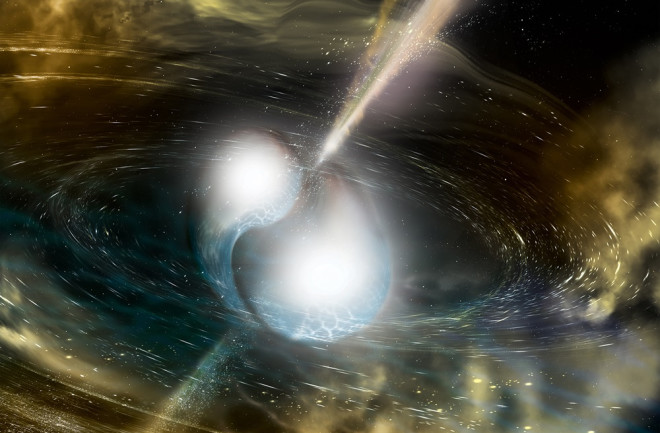The dead cores of two stars collided 130 million years ago in a galaxy somewhat far away.
The collision was so extreme that it caused a wrinkle in space-time — a gravitational wave. That gravitational wave and the light from the stellar explosion traveled together across the cosmos. They arrived at Earth simultaneously at 6:41 a.m. Eastern on August 17.
The event prompted worldwide headlines as the dawn of “multimessenger astronomy.” Astronomers had waited a generation for this moment. But it was also the first-ever direct confirmation that gravity travels at the speed of light.
The Speed of Gravity
We all know light obeys a speed limit — roughly 186,000 miles per second. Nothing travels faster. But why should gravity travel at the same speed?
That question requires a quick dive into Albert Einstein’s general relativity, or theory of gravity — the same theory that predicted gravitational waves a century ago.
Einstein overthrew Isaac Newton’s idea of “absolute time.” Newton thought time marched onward everywhere at an identical pace — regardless of how we mortals perceived it. It was unflinching. By that line of thinking, one second on Earth is one second near a black hole (which he didn’t know existed).
Newton also thought gravity acted instantaneously. Distance didn’t matter.
It’s All Relative
But then Einstein showed that time is relative. It changes with speed and in the presence of gravity. One of the ramifications of that is that you can’t have simultaneous actions at a distance. So information of any kind has a finite speed, whether it’s a photon — the light-carrying particle — or a graviton, which carries the force of gravity.
“In relativity, there is a ‘speed of information’ — the maximum speed that you can send information from one point to another,” says University of Wisconsin-Milwaukee physicist Jolien Creighton, an expert on general relativity and member of the LIGO team that first spotted gravitational waves.
Creighton explains that in electromagnetism, when you shake an electron, it creates a change in the electric field that spreads out at the speed of light. Gravity works the same way. Shake a mass and the change in the gravitational field — the gravitational wave — propagates at that same speed.
“So the fact that the speed of gravitational waves is equal to the speed of electromagnetic waves is simply because they both travel at the speed of information,” Creighton says.
There’s an easy way to picture this, too. Imagine the sun vanished right now. Earth wouldn’t just drift into space instantly. After eight minutes, Earth would go dark and simultaneously push off in a straight line.

